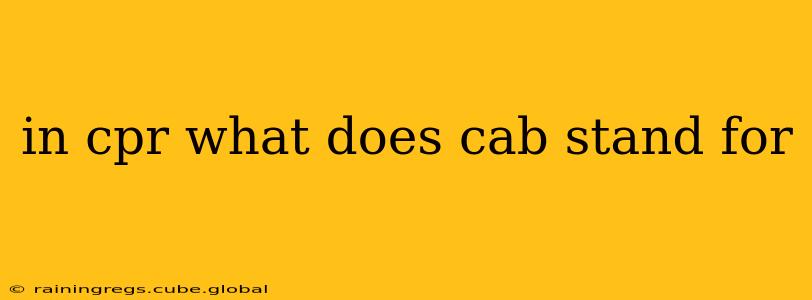Cardiopulmonary resuscitation (CPR) is a life-saving technique used when someone's breathing or heartbeat has stopped. Understanding the steps involved is crucial, and a key element of modern CPR training is the CAB sequence. But what does CAB stand for in CPR? Let's break it down.
CAB stands for Chest Compressions, Airway, Breathing. This sequence represents the order of actions in performing CPR, a shift from the older ABC (Airway, Breathing, Compressions) method.
Why the Change to CAB?
The change from ABC to CAB reflects advancements in CPR research. Studies have shown that starting chest compressions immediately after recognizing cardiac arrest significantly improves the chances of survival. Getting blood circulating to the brain and heart quickly is paramount. Delaying compressions to first check the airway and breathing can dramatically reduce the effectiveness of CPR.
Understanding Each Step of CAB
Let's examine each component of the CAB sequence in detail:
C - Chest Compressions:
- The Importance: Chest compressions are the most crucial part of CPR. They manually pump blood throughout the body, delivering oxygen to vital organs like the brain and heart until normal heart rhythm is restored or professional medical help arrives.
- How to Perform: Proper technique involves placing the heel of one hand in the center of the chest (between the nipples), placing the other hand on top, and interlacing fingers. Push hard and fast, aiming for a depth of at least 2 inches (5 cm) for adults, and allowing the chest to fully recoil between compressions. The recommended rate is 100-120 compressions per minute.
- When to Start: Begin chest compressions immediately upon recognizing cardiac arrest, unless the person is clearly breathing and has a pulse.
A - Airway:
- Opening the Airway: Once chest compressions are initiated, the next step is to ensure a clear airway. This is typically done by performing a head-tilt-chin-lift maneuver. Gently tilt the person's head back and lift their chin to open the airway. Avoid excessive neck extension if a neck injury is suspected.
- Checking for Obstructions: Look, listen, and feel for breathing. Look for chest rise and fall, listen for breath sounds, and feel for air on your cheek.
- Importance of Airway Clearance: A blocked airway prevents oxygen from reaching the lungs. If an obstruction is present (such as vomit or a foreign object), carefully remove it before proceeding with rescue breaths.
B - Breathing:
- Rescue Breaths: After opening the airway and ensuring it's clear, give rescue breaths. For adults, give two rescue breaths, each lasting about one second. Ensure a good seal around the person's mouth, and watch for chest rise to confirm that air is entering the lungs.
- Breath Delivery: The breaths should be delivered with sufficient force to make the chest visibly rise.
- Ratio of Compressions to Breaths: The standard ratio for adult CPR is 30 chest compressions followed by two rescue breaths. This cycle is repeated until professional help arrives or the person shows signs of recovery.
Frequently Asked Questions (FAQs)
Here are some common questions about CAB in CPR:
How do I know if someone needs CPR?
If someone is unresponsive, not breathing normally, or only gasping, they may need CPR. Check for a pulse – if there's no pulse, immediate CPR is crucial.
What if I'm not trained in CPR?
Even if you're not trained, starting chest compressions immediately is better than doing nothing. Focus on the chest compressions until professional help arrives.
Is there a difference in CAB for children and infants?
Yes, the techniques and ratios for chest compressions and rescue breaths differ slightly for children and infants. Specialized CPR training for different age groups is recommended.
What if someone starts breathing again?
If the person starts breathing normally, continue to monitor them closely and maintain their airway until professional help arrives.
Where can I learn CPR?
Many organizations offer CPR training courses, including the American Heart Association (AHA) and the American Red Cross.
By understanding the CAB sequence and the importance of each step, you can be better prepared to potentially save a life. Remember, immediate action is critical in cardiac arrest situations. While this information is for educational purposes, obtaining proper CPR certification from a recognized organization is highly recommended for anyone who wants to be prepared to respond to emergencies.
